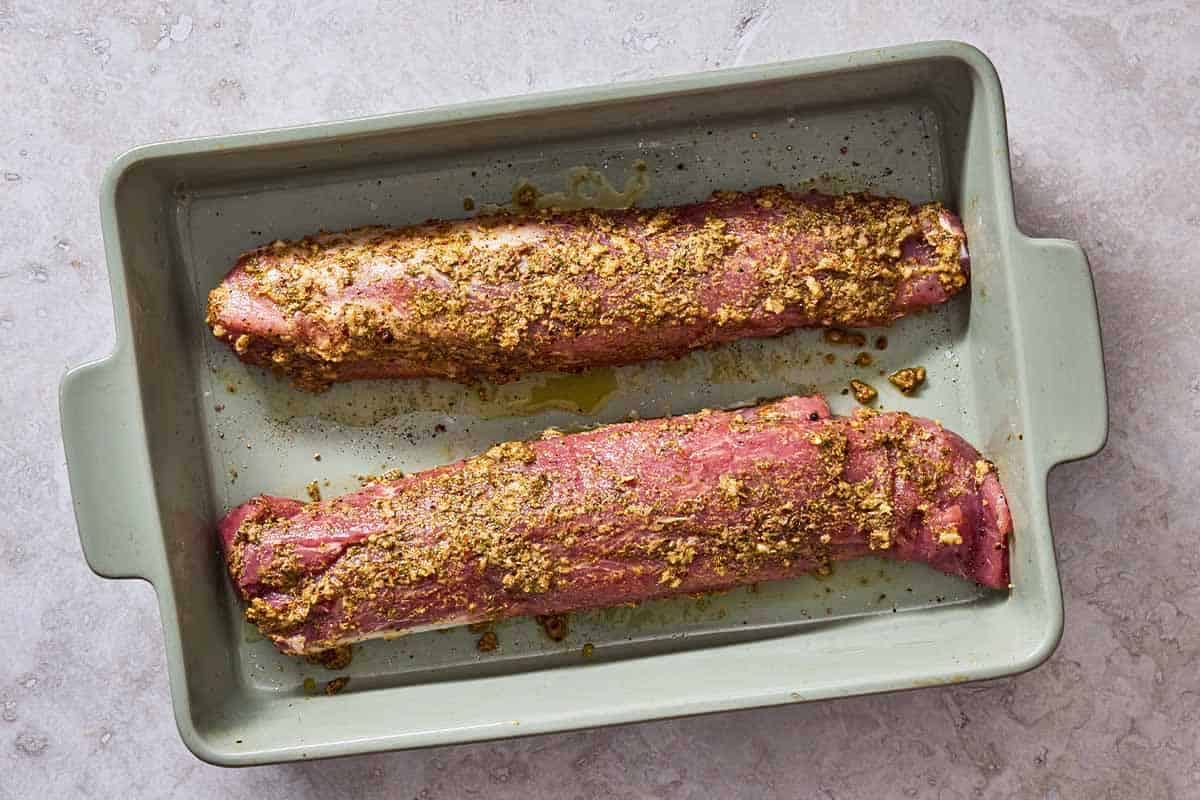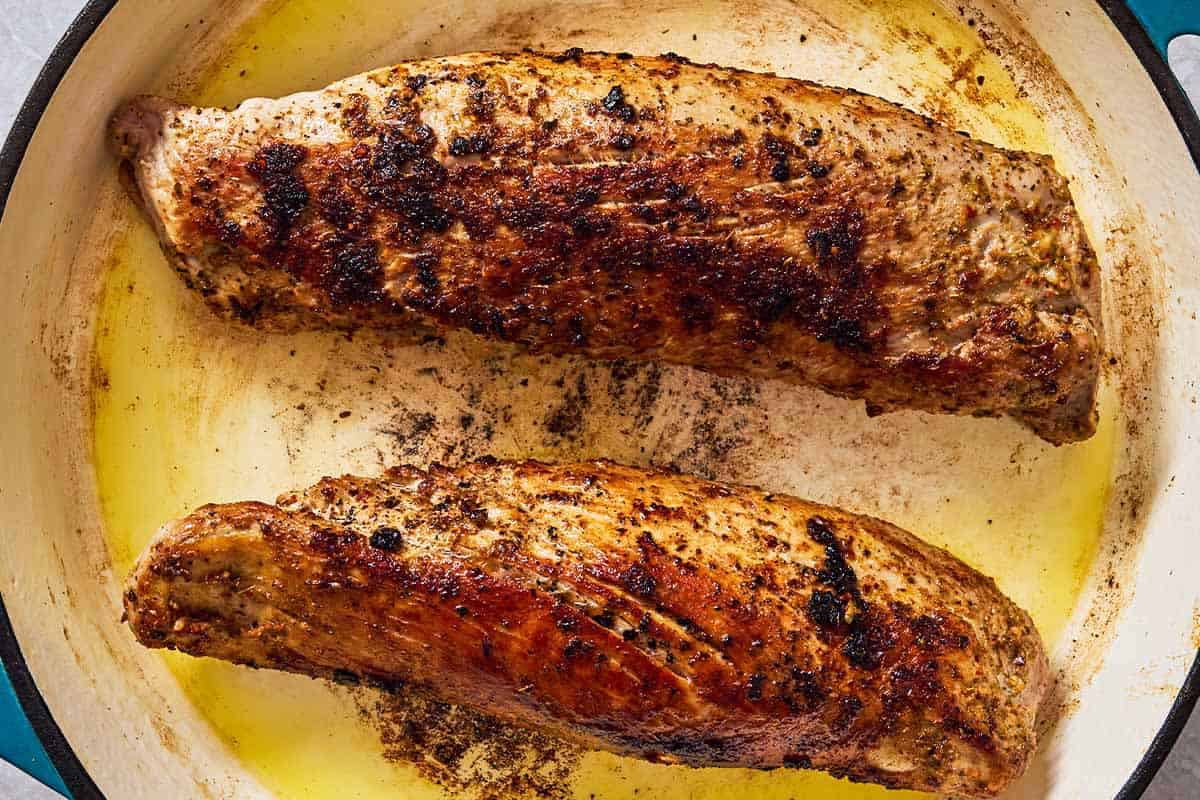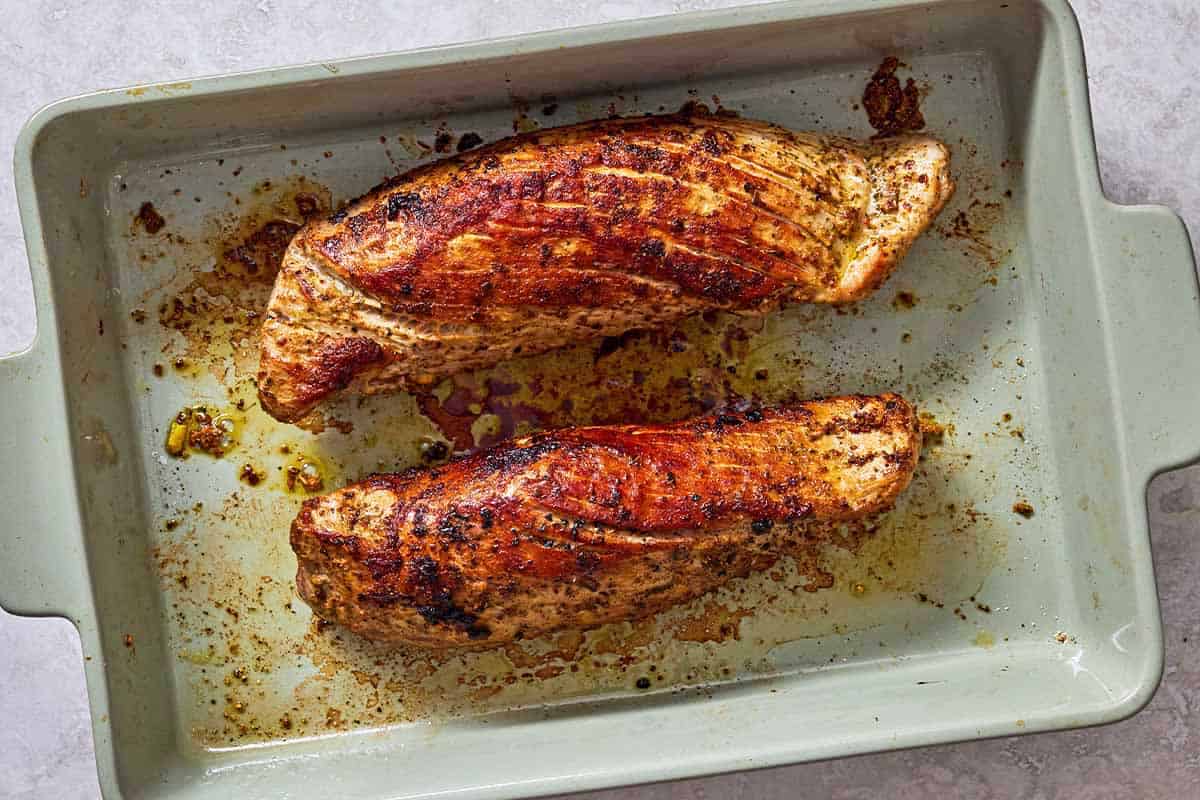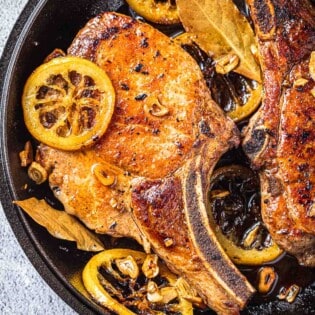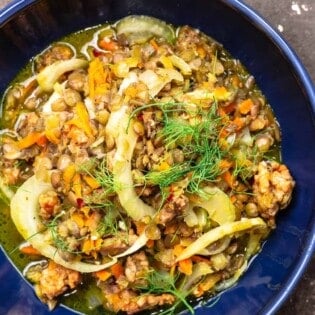This easy pork tenderloin recipe gets the Mediterranean treatment with a bold Greek-style pork tenderloin marinade and zippy Herb and Pistachio Salsa.

* This is a sponsored post on behalf of the National Pork Board. All opinions are my own. *
There’s a lot to love about pork tenderloin. Its long, slender shape means you get a beautifully golden crust with a deliciously juicy center. You just give it a quick sear on your stovetop and finish in your oven—no cheffy skills required!
Plus, it gives a fancy and festive vibe similar to rack of lamb but it’s secretly very affordable. This easy recipe leans on a Souvlaki-inspired pork tenderloin marinade, which loads the meat with a decidedly Mediterranean flavor—garlicky, warming, and aromatic. You’ll want to give yourself at least 3 hours for the spices to penetrate the meat, or get started the night before.
The following is shockingly fast. Pork tenderloin cooks in just 20 minutes or less until it reaches an internal temperature of 145°F, followed by a 3-minute rest. I would go as far as to say that this holiday-fancy tenderloin is downright weeknight-friendly! But I love this pork tenderloin recipe for so many occasions.
And the dish is completely versatile! The leftovers are delicious for lunch served with a Greek Salad. You can also set the medallions and salsa out for an appetizer or give them the spotlight they deserve on a big platter right in the center of your table.
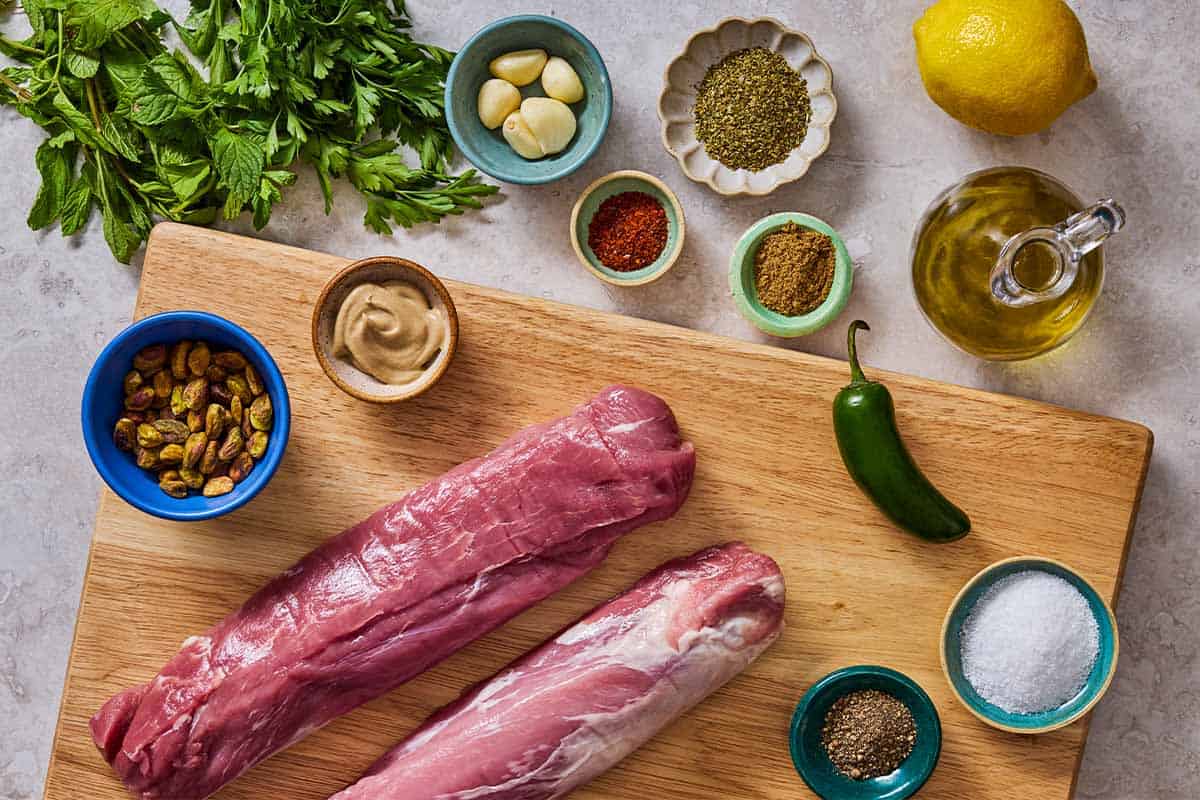
Ingredients for this Pork Tenderloin Recipe
You can, of course, use this pork tenderloin marinade on its own. But I love how the Mediterranean-style salsa gives the meat a zippy, fresh, and spicy boost and more textural variety. It’s not your average pork tenderloin recipe! Here’s what you’ll need:
For the Pork Tenderloin Marinade
- Pork tenderloins: Tenderloins are a narrow tube-shaped cut (not to be confused with pork loins which are much wider and thicker). This muscle doesn’t get used much, so it’s incredibly tender and rather mild in flavor—perfect for loading with all my favorite flavor-makers! Look for medium-sized tenderloins around 1 to 1 1/4 pounds each.
- Garlic: It wouldn’t be a Mediterranean-style pork tenderloin without garlic! A good amount of fresh garlic gives this pork recipe its signature sweet-savory and peppery notes.
- Dijon mustard adds richness and a sharp, peppery kick.
- Greek oregano: The dominant herb that’s behind just about every Greek classic, oregano is a potent dried herb that adds an aromatic, lemony brightness.
- READ MORE: Oregano guide
- TRY IT: Find authentic Greek oregano in our spice shop.
- Ground coriander: Adds a distinctly warming, slightly sweet, and citrusy flavor. If you don’t have coriander feel free to substitute with ground cumin.
- Aleppo pepper: I love the way Aleppo pepper adds a very mild, nuanced warmth without overwhelming the flavor, but red pepper flakes work well as a substitute.
- Extra virgin olive oil: Used in both the salsa and the marinade, olive oil plays an important (though supporting) role in this recipe. First, it infuses the pork with the marinade’s spices and aromatics. Second, it acts as a base for the salsa. I recommend a smooth oil that won’t compete with the other seasonings, like our Arbequina or Koroneki.
- Kosher salt and ground black pepper perk up the other flavors.

For the Herb and Pistachio Salsa
- Jalapeño: Adds a good kick and fresh vegetable flavor. The seeds hold most of the burn, so for a milder option, remove the seeds before chopping.
- Fresh herbs: Mint and parsley add a fresh quality and play off the lemony notes of the dried spices.
- Pistachios: Add crunch and buttery richness. Look for unsalted or raw pistachios, as nuts tend to be oversalted.
- Lemon: The zest gives the salsa an aromatic quality, while the juice adds a hit of acid to balance the richness of the meat.

How to Cook Pork Tenderloin
The trick to cooking pork tenderloin is creating a satisfying golden crust and juicy center. I like first to infuse it with a Mediterranean-style pork tenderloin marinade — giving the tenderloin at least 3 hours to soak in all the flavor.
From there, I quickly sear it over high heat on the stove until it’s golden brown all over resulting in a beautiful crust, and then finish it in the oven until it reaches an internal temperature of 145°F, followed by a 3-minute rest. This results in a juicy, never-dry tenderloin. Here are the steps:
Make the Pork Tenderloin Marinade
- Season the pork. Pat two (1 to 1 1/4 pound) pork tenderloins dry and set on a 9 x 13-inch baking dish. Season well with salt and pepper on all sides.
- Prepare the marinade mixture. In a small mixing bowl, whisk together 5 minced garlic cloves, 1 tablespoon Dijon mustard, 2 teaspoons dried Greek oregano, 1 teaspoon ground coriander, 1 teaspoon Aleppo pepper (or red pepper flakes), and 1/2 cup olive oil.
- Marinate the pork. Rub the pork all over with the marinade mixture. Cover and refrigerate for at least 3 hours, and up to 24 hours.
Sear and Bake the Pork Tenderloin
- Get ready to cook. Position a rack in the center of your oven and preheat to 375°F. Remove the pork from the fridge and set aside at room temperature until the oven is hot.
- While the oven heats, make the Herb and Pistachio Salsa. To a medium mixing bowl, add 1 chopped jalapeno, 1/2 cup each chopped parsley and mint, and 1/3 cup crushed pistachios. Liven up the flavor with the zest and juice of 1 lemon and a small pinch of salt and pepper. Add enough olive oil to cover (about 1/3 cup) and mix well to combine. Cover and keep in the fridge until you are ready to roast the pork.
- Sear the pork. When your oven is hot, set a large skillet over medium-high heat, and coat with olive oil (1 to 2 tablespoons). When the oil is shimmering, add the tenderloins (do this in batches if your skillet is not large enough). Sear the pork, turning on all sides until golden brown all over, about 5 to 8 minutes in total. Return the pork to the baking dish in which you marinated it.
- Roast. When the oven is ready, roast the pork for about 18 to 20 minutes, until a meat thermometer inserted into the thickest part registers 145°F. Remove the pork from the heat and allow it to rest for 3 minutes.
Slice and Serve
- Serve. After the pork has rested, spoon the juices from the baking dish on top. Slice into medallions and serve with the herb and pistachio salsa spooned on top.
Temperature for Pork Tenderloin
The safest internal temperature for pork tenderloin is 145°F followed by a 3-minute rest. Keep in mind that the internal temperature will continue to rise as it rests. Take the tenderloin out of the oven when the thickest part reads 145°F on a meat thermometer and let it rest for 3 minutes.
There is a common misconception that you have to cook pork like other meats, which requires between 160-165°F. This is why people often think that pork is dry. It’s just overcooked! A properly cooked pork tenderloin is one of the juiciest cuts of meat out there. Just be careful not to overcook it.

What to Serve with Pork Tenderloin
For a classic holiday dinner with a Mediterranean twist, kick off the party with Holiday Sangria and a Mezze Platter.
Once everyone settles in, start with a bright and crunchy fresh salad to complement the pork. This Endive Salad with its tart, bitter, and herbal notes, comes to mind.
Serve the tenderloin recipe with something starchy to round out the meal, like these Roasted Garlic Mashed Potatoes. For dessert, keep things refreshing yet cozy with Easy Baked Apples.
If you’re searching for more pork ideas and cooking inspiration visit pork.org for helpful tips and resources.
More Mediterranean Pork Recipes
Browse all Mediterranean recipes.
Visit Our Shop.
Roasted Pork Tenderloin with Herb and Pistachio Salsa

Ingredients
- 2 (1 to 1 1/4 pounds) pork tenderloins
- Kosher salt
- Ground black pepper
For the Marinade Mixture
- 5 medium garlic cloves minced
- 1 tablespoon Dijon mustard
- 2 teaspoons dried Greek oregano
- 1 teaspoon ground coriander
- 1 teaspoon Aleppo pepper or red pepper flakes
- Extra virgin olive oil
For the Herb and Pistachio Salsa
- 1 jalapeño, chopped
- 1/2 cup fresh parsley, chopped
- 1/2 cup fresh mint, chopped
- 1/3 cup shelled unsalted pistachios, chopped or roughly crushed
- 1 lemon, zested and juiced
- Kosher salt
- Ground black pepper
- Extra virgin olive oil
Instructions
- Season the pork. Pat the tenderloins dry and set on a 9 x 13-inch baking dish. Season well with salt and pepper on all sides.
- Prepare the marinade mixture. In a small mixing bowl, whisk together the garlic, Dijon, oregano, coriander, Aleppo pepper (or red pepper flakes), and enough olive oil to generously coat the tenderloins (about 1/2 cup).
- Marinate the pork. Rub the pork all over with the marinade mixture. Cover and refrigerate for at least 3 hours, and up to 24 hours.
- Get ready to roast. Position a rack in the center of your oven and preheat to 375°F. Remove the pork from the fridge and set aside at room temperature until the oven is hot.
- While the oven heats, make the Herb and Pistachio Salsa. To a medium mixing bowl, add the jalapeño, parsley, mint, pistachios, lemon zest, lemon juice, and a small pinch of salt and pepper. Add enough olive oil to cover (about 1/3 cup). Mix well to combine. Cover and keep in the fridge until you are ready to roast the pork.
- Sear the pork. Heat 1 to 2 tablespoons of olive oil in a large skillet over medium-high heat. When the oil is shimmering, add the tenderloins (do this in batches if your skillet is not large enough). Sear the pork, turning on all sides until golden brown all over, about 5 to 8 minutes in total. Return the pork to the baking dish in which you marinated it.
- Roast. When the oven is ready, roast the pork for about 18 to 20 minutes, or until a meat thermometer inserted into the thickest part registers 145°F. Remove the pork from the heat and allow it to rest for at least 3 minutes.
- Serve. After the pork has rested, spoon the juices from the baking dish on top. Slice into medallions and serve with the herb and pistachio salsa spooned on top.
Video
Notes
- Shop this recipe: Visit our shop to browse quality Mediterranean ingredients including the olive oil and spices used in this recipe.
- Be careful not to overcook the pork! Cooking pork like other meats, which require an internal temperature of 160-165°F is a common misconception that will result in a dry pork tenderloin. Take the pork out of the oven when it registers at an internal temperature of 145°F.
Nutrition
Bundle and Save!
Four of our best-selling signature olive oils, perfect for everyday use.





